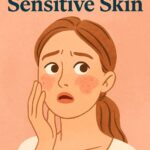
You shave your legs, they feel smooth for five minutes, and then you notice it in the light. Tiny dark dots in every pore. Maybe a little rough. Maybe itchy. You run your hand over your thighs and it is not glassy at all. That bumpy, speckled look is what a lot of people call strawberry skin.
Most of the time strawberry skin is not a rash and it is not an infection. It is usually clogged pores and irritated follicles after shaving. Hair that was cut blunt can sit just below the surface and show as dark dots. Dead skin and oil collect in the opening and make it look even darker. Sometimes those same pores get inflamed and start heading toward ingrown hairs.
The good news: you can usually calm this at home with cleaner shave habits, the right wash routine in the shower, and smarter moisture after. You do not need to scrub yourself raw. You do not need to pick.
Below is a plan you can repeat every time you shave to keep pores clearer, reduce that dotted look, and stop a lot of the redness and itching that shows up later.
What strawberry skin actually is (and what it is not)
Strawberry skin is basically clogged or irritated follicle openings. After shaving, each pore is more open than usual and a little angry. Oil from your skin, old product, and even tiny bits of cut hair can sit in that opening and make it look like a dark seed under the skin. On fair skin, that can show as dots. On deeper skin tones, it can show as texture and darker speckling.
You are also dealing with micro-irritation. A razor is still a blade. If it drags instead of gliding, it lightly scrapes the top layer of skin and leaves that area more reactive. That irritation can make the pore look red or shadowed, which makes the dots stand out more.
What strawberry skin is not: it is not always keratosis pilaris. KP tends to be persistent rough bumps that feel dry and grainy even when you have not shaved. Strawberry skin usually shows up right after shaving or waxing and calms down between hair removal sessions if you treat it well.
When it starts getting painful, hot, or pus filled, that is not basic strawberry skin anymore. That is a possible ingrown hair or folliculitis, which is mild follicle infection. That needs different care. If you are seeing pus, skip shaving that area and talk with a clinician.
Why dull razors make strawberry skin worse
If your razor is not sharp, it does not cut cleanly. It drags. Dragging does two annoying things.
First, it roughs up the pore opening. The more scraping you do, the more inflamed that follicle gets, which means more visible dots later. That is why legs can look fine after the first pass with a new blade, then blotchy and angry two weeks later when you are squeezing the last life out of a cartridge.
Second, a dull razor tends to cut the hair unevenly and sometimes too low. Instead of a clean cut at skin level, it can sort of chew it off. That blunt, frayed edge sits just under the surface like a dark speck. On people with thicker or darker hair, those specks show immediately as “strawberry dots.” On curlier hair, that blunt end is more likely to curl under and turn into an ingrown.
So if your legs always look dotted right after shaving and stay dotted for days, the first fix is simple and not fancy. Change blades more often. Use light pressure. Let the razor glide instead of pressing down like you are mowing a lawn.
Your wash routine in the shower (what to do before you shave)
Your pre-shave wash matters. You want the skin soft, the pores clear of heavy residue, and the blade able to glide.
Step 1: Use warm water, not super hot. Warm water softens the hair so it cuts cleaner but does not strip your skin barrier as hard as very hot water. Long, steaming showers can leave skin tight and itchy and make post-shave irritation worse. Shorter and warm works better.
Step 2: Wash the area first using a gentle, fragrance-free body wash that will not sting or leave a film. This helps lift sweat, oil, and deodorant residue from places like thighs and bikini line so your razor is not loading up with grime and bacteria on the first swipe. If you are prone to stinging, look at the kind of formulas we talk about in Best Body Wash for Sensitive Skin. A calmer cleanser now means less burning later.
Step 3: Let the area sit in warm water for a couple minutes before you shave. That softens the hair shaft so the blade slices instead of rips.
Step 4: Use a real shave product or at least a slippery, cushiony cream. Dry shaving or shaving with just water makes drag way worse. More drag means more angry pores. More angry pores means more dots.
Optional: Very gentle exfoliation, but not every day. Light chemical exfoliation (not a harsh physical scrub) a couple times a week on legs can help keep dead skin from plugging the follicle opening. You do not scrub right before you shave, because that stacks irritation. Think of it like maintenance on off days, not “scrub then shave in one shot.”
Moisture strategy right after shaving (this part matters)
The first 5 to 10 minutes after you shave decides how red and bumpy your legs look tomorrow. This is where a lot of people make it worse without realizing.
Right after shaving, rinse and pat skin mostly dry. Do not rub with a towel. Rubbing creates extra friction on skin you literally just scraped with a blade.
While skin is still slightly damp, use a soothing, fragrance-free moisturizer. Thicker cream or lotion is better than a thin spray. You want something that calms irritation, supports the skin barrier, and helps seal in water so the pores do not dry out and tighten into that itchy “I need to scratch my thighs” feeling.
Then, once that first layer has soaked in a little, you can follow with a more occlusive product (occlusive means something that sits on top and locks moisture in). This could be a balm or an oil-based product. The goal here is not “grease your legs forever.” The goal is to trap water in the skin you just shaved so those open follicles do not dry out, get crusty, and darken.
That layering order matters. Water first, then cream, then something that seals. If you slap a heavy oil onto bone-dry skin, you are just coating dryness. If you seal in moisture while the skin is still hydrated, you calm the look of those dots much faster.
This also helps with that after-shave sting. Your skin is less likely to freak out and overreact, which lowers the chance that every single pore turns into a visible dark seed.
The big rule: stop picking at the dots
It is tempting to see every dark pore and think “I’ll just squeeze it out.” Do not. That is how you turn mild post-shave texture into actual injury.
Picking, scraping with nails, digging with tweezers, or trying to “pull the hair out a little so it’s smooth” all do the same thing. You break the surface. Now the follicle is open to bacteria, and you are basically inviting either razor burn style irritation or a true ingrown.
If you have areas that always get angry, especially inner thighs and bikini line, treat them like high risk zones. Keep blades very fresh. Use more slip when shaving. Moisturize right away. If a spot still blows up into a painful bump, treat it like an ingrown, not like a clogged pore you need to pop. We go into calming and protection steps in Bikini Line Ingrown Hair Treatment That Works.
Also, stop dry shaving quick touch ups on old stubble. Those rushed “just a couple swipes” without water or shave cream are almost guaranteed to give you dots and burn.
When strawberry skin is heading toward razor burn or ingrown hairs
Strawberry skin is mostly visual. Razor burn is when it hurts. Ingrown hair is when it hurts and swells.
Watch for these signs that you are past “just clogged pores.”
The area feels hot, sore, or stingy to the touch, not just a little itchy.
You have angry red patches or lines that match where the razor scraped. That is burn, not just dots.
You feel a hard bump under the skin that is painful when you press it, and you cannot actually see the hair tip. That is likely an ingrown starting.
If you are already in that zone, take a break from shaving on that area and switch to calming care. We lay out 48-hour damage control in Razor Burn Recovery in 48 Hours, including cooling, protection, and when to leave it alone so it heals flat instead of scarring.
If bumps get warm, swollen, or start to fill with yellow fluid, that can be infection. At that point you should speak with a clinician. Do not keep shaving over it.
Final Thoughts
Strawberry skin on legs is mostly about irritated follicles holding on to oil and cut hair after shaving. It looks dramatic, but most of the time it is about technique, not “bad skin.”
Your main controls are simple habits. Use a sharp razor with light pressure. Clean the area first with a gentle wash, not a harsh perfumed soap. Shave on softened hair with real slip. Right after shaving, seal in moisture while skin is still damp so pores do not dry out and get angry. And do not pick at the dots.
If you start getting soreness, heat, or raised bumps, treat that like razor burn or an ingrown situation, not “more scrubbing.” That is when you pull back, protect the skin, and let it calm.
Most people see a big improvement just by fixing those basics and moisturizing correctly after every shave instead of waiting until the skin already itches.
See also
If you shaved fast and now the area is stinging, red, or almost raw, follow the calm-down plan in Razor Burn Recovery in 48 Hours. For bumps in places that rub, especially bikini line and inner thighs, check Bikini Line Ingrown Hair Treatment That Works for how to protect the follicle instead of digging at it. If your current soap leaves you prickly and tight the second you towel off, switching to the type of gentle, low-fragrance cleanser we talk about in Best Body Wash for Sensitive Skin can keep pores from freaking out in the first place.
For legs that always feel dry and ashy after shaving, locking in water right after you step out of the shower can make the dots look softer by morning. You can borrow barrier tips from Best Body Lotion for Dry Skin for sealing in moisture on lower legs and shins, and if you also deal with rough, chicken-skin texture on arms or thighs, the routine in Keratosis Pilaris Care: Body Routine That Smooths Bumps can help keep buildup from sitting in the follicle and turning into that dotted strawberry look.
FAQs
1. Is strawberry skin permanent?
No. The dots are usually clogged or irritated follicles right after shaving. With a sharper razor, a gentler wash routine, and immediate moisture after the shower, most people see them calm down over a few days between shaves.
2. Will exfoliating fix it overnight?
Not overnight. Gentle chemical exfoliation on off days can help keep pores clearer, but harsh scrubbing or using a gritty scrub right before you shave will just make the follicles angrier. Over-scrubbing can also lead to razor burn.
3. Can I prevent strawberry skin by waxing instead of shaving?
Sometimes. Waxing pulls hair from the root, so you do not get that blunt dark stump sitting in the pore. But waxing can still cause ingrown hairs, especially on curlier hair types. You still need soothing moisture after hair removal and no picking.
4. Is lotion enough, or do I need body oil too?
Lotion or cream gives water and barrier support. An occlusive step on top (like a light oil or balm) helps lock that water in. The trick is timing. Apply while skin is still slightly damp after shaving so you trap moisture instead of sealing in dryness.
5. When should I see a doctor about it?
If bumps are painful, hot, swollen, or filled with yellowish fluid, or if you keep getting the same angry spot over and over, talk to a clinician. That can be an ingrown hair that is getting infected or folliculitis. Do not keep shaving over that area until it is cleared.
Affiliate Disclosure
If you purchase through links on our site, we may earn a small commission at no extra cost to you.




